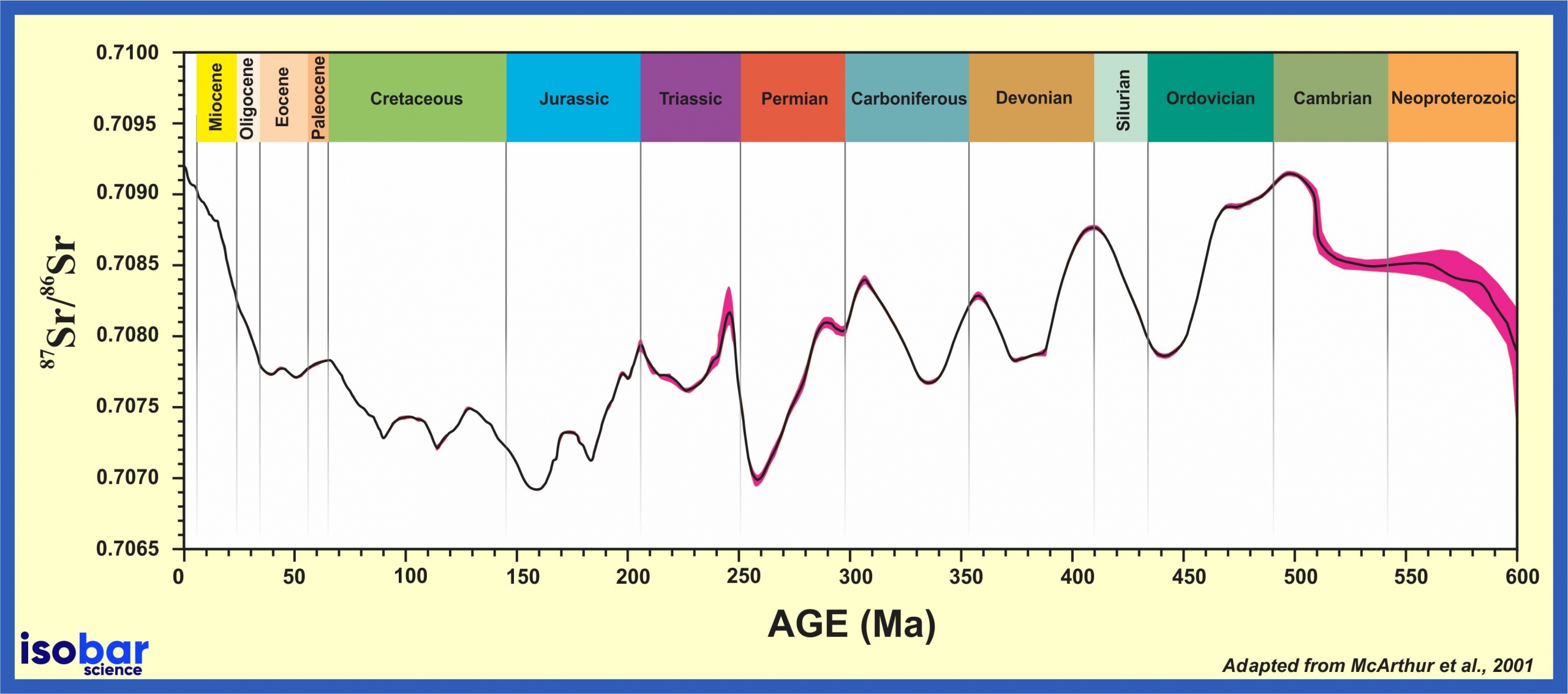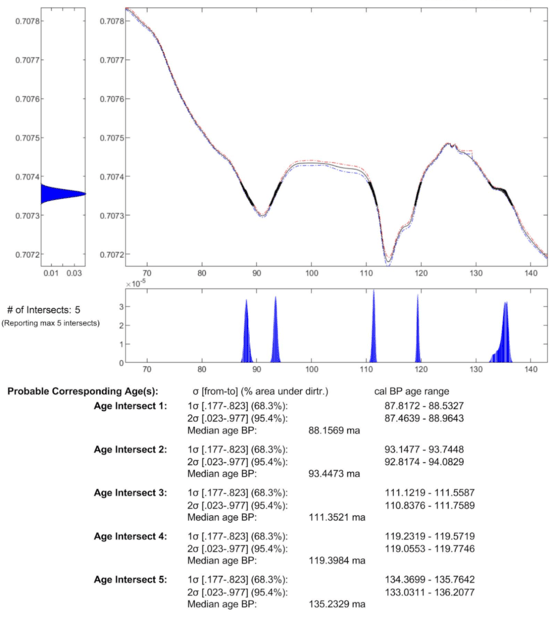Strontium-Strontium Dating
Strontium isotopic ratios (87Sr/86Sr) can be used to date marine samples over the past 600 million years with a time resolution of 1 million years.
The Strontium Seawater Curve was developed through the 87Sr/86Sr measurement of thousands of marine sediments and fossils over the Phanerozoic Eon. Precipitation of marine biogenic carbonates and phosphates involves uptake of strontium from seawater with the 87Sr/86Sr ratio identical to that of the oceanic value at the time of incorporation. This 87Sr/86Sr ratio of the ocean varies through time, creating a predictable seawater curve that can be used for dating calibration. The fluctuations through time represent a record of global Earth tectonic, erosional, and weathering processes (Turchyn and DePaolo, 2019). Since this ratio is always globally uniform in the oceans at any time, the fluctuation in the 87Sr/86Sr ratio can be used as a stratigraphic marker to evaluate the age of marine Sr-bearing carbonate and phosphate minerals. The most recent and complete compilation of the Phanerozoic data is provided in McArthur et al, 2020.

Strontium isotopic ratio (87Sr/86Sr) of seawater during geological time based on analyses of bulk sediment, unaltered brachiopods, belemnites, conodonts and foraminifera samples from various locations around the world. Red area denotes the 95% confidence interval. Adapted from McArthur et al., 2001.
Assumptions
To use the Sr isotopic ratios of marine carbonate for dating, it is assumed that the marine organism is grown fully in marine environment. Marginal marine environments like estuaries and river mouths as well as coastal environments typically retain brackish waters due to mixing with the riverine freshwater. Waters from these environments and the carbonates precipitated in them mostly have different 87Sr/86Sr ratios compared to the fully marine seawater. It is also critical to know that any post-depositional diagenesis processes may alter the original Sr isotopic signature of the sample resulting in deviated age results. This method works best for time periods with long-term unidirectional shifts in the 87Sr/86Sr ratio, such as the Tertiary, but technically can work over the past 600 million years.
Strontium Geochronology Method
The service primarily consists of measuring the 87Sr/86Sr ratios in the sample using multi-collector inductively coupled plasma mass spectrometer (MC-ICP-MS) and age determination through McArthur et al (2020) marine 87Sr/86Sr curve utilizing Isobar-specific calibration software, Isobar-Sr.
Sample Types
Marine samples can be dated using this method, as detailed below:
| Sample Type | Size | Sample Preparation |
| Foraminifera | Minimum 5-10 mg | For the best results, make sure your samples are clean and free from clay particles and other detritus. Package in vials (preferably with screw tops), microcentrifuge tubes, or counting slides |
| Shells (bivalves, gastropods, brachiopods) | 100 mg | |
| Corals | 100 mg | |
| Limestone | 100-150 mg |
Strontium Extraction
Low-blank separation of strontium from each sample achieved by extraction chromatography using Eichrom Sr resin following the methods of Pourmand et al., 2014 and Pourmand and Dauphas, 2010.
Isotope Measurement
Device: Neptune Plus multi-collector inductively coupled plasma mass spectrometer (MC-ICP-MS) with an Apex-Q desolvation nebulizer or a self-aspirating nebulizer, (SSI) depending on sample type and overall strontium concentration in the sample.
Measurement Results
Strontium isotope ratio data are reported as 87Sr/86Sr ratios. The analytical accuracy and precision were assessed by multiple measurements of certified reference material (SRM 987) during the analysis. Uncertainties for each sample measurement is presented as the 95% confidence interval (CI). The measured 87Sr/86Sr ratios were corrected for mass bias and isobaric interferences and the final ratio was further adjusted relative to the accepted value of 0.710248±0.000003 (McArthur et al, 2001) for SRM 987 to allow comparison with literature measurements of radiogenic Sr isotopes.
| Lab ID | Submitter ID | Material | 87Sr/86Sr Raw | ± 95% CI | 87Sr/86Sr Adjusted | ± 95% CI |
| IS-0X | CB-1 | Coral | 0.707525 | 0.000014 | 0.707505 | 0.000014 |
| IS-0X | CB-2 | Coral | 0.707699 | 0.000005 | 0.707688 | 0.000005 |
| IS-0X | CB-3 | CB-3 | 0.707475 | 0.000010 | 0.707455 | 0.000010 |
Age Calibration
The 87Sr/86Sr ratios in the samples are further intercepted with the marine 87Sr/86Sr curve (McArthur et al, 2020) and the 1σ and 2σ age ranges along with the median ages are presented as years before present (B.P.). The results will produce a series of statistically likely age ranges and median ages in calibrated years before present (cal BP) at 1σ and 2σ probabilities (68.3% and 95.4%, respectively). To be able to choose the best time frame to conduct the age determination, the stratigraphical information and geological time frame will be needed. Supplementary evidence is required on behalf of the researcher to better confine the time frame.[Example Results]

Example results from a single sample, resulting in 5 intersections with the Strontium Seawater Curve and thus 5 different age ranges corresponding to the peaks in the plot above.
References
McArthur, J. M.; Howarth, R. J. and Bailey, T. R., 2001: Strontium Isotope Stratigraphy: LOWESS Version 3: Best Fit to the Marine Sr‐Isotope Curve for 0–509 Ma and Accompanying Look‐up Table for Deriving Numerical Age Source. The Journal of Geology, vol. 109, no. 2, pp. 155-170.
McArthur J.M., Howarth R.J., Shields G.A. and Zhou Y. 2020. Strontium isotope stratigraphy, Chapter 7, p211 – p238. In: Gradstein F.M., Ogg J.G., Schmitz M.D. and Ogg G.M. A Geologic Time Scale, Elsevier B.V., Vol 1 of 2, 1357 pp, 2020.
Turchyn, A.V., and DePaolo, D.J., 2019. Seawater chemistry through Phanerozoic time. Annu. Rev. Earth Planet. Sci., vol.47, pp. 197-224.
